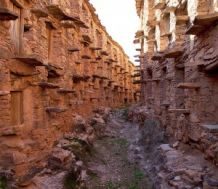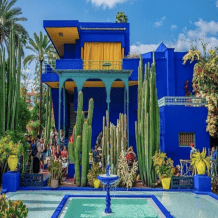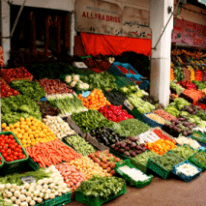Moroccan Mint Tea Traditions, The Secret Ingredients
Morocco’s tradition of tea dates back to the 12th century BC. There are various theories on the origin of tea in the Maghreb. Some say the Berbers (Amazigh) imported tea from Asia, while others believe that Queen Anne Stuart of Great Britain introduced tea to the Moroccan Sultan as a ploy to release British prisoners.

Moroccan mint tea, referred to as “Berber Whiskey” or Maghrebi Mint Tea is one of the pillars of Moroccan culture. In Morocco, tea is sipped all hours of the day. When Moroccans welcome guests to their homes they sip tea, when they celebrate a birth or wedding ceremony or death, they sip tea and when they share meals together they sip tea. Tea is sipped slowly 20 or even 30 times a day in Morocco! When a glass of tea is offered, it is a cultural taboo to refuse. Declining an offer of Moroccan tea is considered impolite given many consider it part of a bonding experience. While there are many stories of tea told throughout Morocco, one shared consensus is, the ritual of Moroccan tea is an art.
Morocco’s tradition of tea dates back to the 12th century BC.
“Tea in Morocco, is not just about boiling the water and adding mint, it is ceremonial art, a ritual for us, similar to the Chinese and Japanese,” says Saoud, teacher, and host of La Maison Arabe’s tea ceremony. Souad leads a tea ceremony that is part of La Maison Arabe’s daily cooking classes offered.
Tucked away into a well-manicured alley with palm trees, out of sight from the bustling Marrakech medina, sits the exquisitely designed boutique hotel. La Maison Arabe. All La Maison Arabe cooking classes are led by a Dada Chef and a host offers first-hand insights about Moroccan Tea traditions. Each class includes a traditional tea ceremony.
Moroccan tea has medicinal and beauty benefits. Herbal teas are made from Morocco’s diverse kingdom of organic plants. There are more than 4,200 species which have been identified as endemic and 400 are classified as products for medicinal or aromatic use.
Moroccan Mint tea traditions are passed from generation to generation. The ritual of Moroccan tea can be observed in a private home, or participating in a cooking class or in the souks. If you ask a Moroccan about memories of their childhood, they will often share an image of their mother in the kitchen, blending together an herbal mint tea to ward off a cold or improve a family member’s digestion.
There are 3 principal ingredients in nearly every cup of Moroccan Mint Tea. They are Gun Powder, Beetroot Sugar, and Spearmint.

#1: Gunpowder:
Considering how frequently Moroccan mint tea is consumed, many people are surprised to learn that tea is not grown in Morocco. Tea used by Moroccans is imported from China. The base of Moroccan mint tea is gunpowder, which closely resembles actual gunpowder and looks similar to rolled up pellets. While gunpowder is the equivalent to green tea, it tastes significantly stronger than the type of green tea most people are familiar with. When blended with Moroccan herbs or fresh mint, gunpowder’s bold and smoky taste lends a unique flavor to the tea itself.
#2: Beetroot:
Another important ingredient in Moroccan tea is sugar, however, not just any sugar. Moroccan’s use a few wedges of healthy Beetroot sugar to enhance the flavor of their tea. Beetroot sugar is grown in Morocco, comes from the beetroot vegetable which is packed with minerals and vitamins. Sipping tea in Morocco without Beetroot or Cane sugar is rare. However, as the result of foreign influence and diabetes, more Moroccans are drinking tea today with less or no added sugar. Moroccan tea without sugar tends to be more pungent and stronger in taste. The combination of gunpowder and mint without sugar cause the tea to take on a bitter flavor.
#3: Spearmint:
There are several different kinds of mint grown in Morocco, however, the consistent choice is spearmint. Spearmint has a clear, pungent, and mild aroma, making it the traditional choice used in Moroccan mint tea culture.

Medicinal Benefits of Moroccan Tea:
There are many types of teas that are consumed in Morocco. Traditional Moroccan Mint Tea typically sipped with no other ingredients. However, those who prefer to use tea for health benefits in Morocco often infuse their tea with aromatic plants and herbs. Some of the aromatic plants and herbs added to Moroccan mint tea are dried flowers, such as rose petals along with the lemon peel, orange peel, and orange blossom water.
Moroccan Mint Tea – Secret Ingredients – Herbs & Spices Used in Moroccan Tea: Moroccan Mint Tea – Secret Ingredients – Herbs & Spices Used in Moroccan Tea:
- Peppermint – slightly different properties than spearmint, the most relied on mint; it aids digestion.
- Bergamot – relaxing and aromatic.
- Lemon balm – an anti-anxiety and aids in sleep
- Absinth – perfect for winter, supports the gallbladder, and the pancreas
- Sage – assists in digestion and boosts memory
- Saffron – warms the body and regulates hormones
- Tea with orange blossom – aromatic and used on special occasions
- Lemon Verbena – relaxing and fresh sensation.
- Thyme – helps clear unhealthy bacteria, repair gut lining and decrease inflammation
- Geranium – flowery taste in the mint tea and is relaxing
Moroccan mint tea contributes to good health. People who live in deserts or oasis’ like Morocco drink hot tea year-round including summertime! Consuming hot beverages cools the body down and the combination of also Moroccan tea has many powerful ingredients like antioxidants, properties to boost endurance, aid in digestion, increase mental performance, inhibit the growth of bacteria and fungus, and even clear up skin disorders. The antioxidants in Moroccan tea help boost endurance, protect against cardiovascular disease and certain cancers.

How to Make Moroccan Tea:
• Place two teaspoons of gunpowder green tea into a traditional Moroccan teapot.
• Next, add a handful of fresh mint tea
• Add your choice of herbs and a little bit of beetroot sugar (up to 4 chunks)
• Pour boiling water and sugar and let it simmer for a few minutes.
• Then pour out the water and reserve the liquid in a glass.
• Add a little boiling water to swish in the teapot again. This second rinse will take away the bitterness and the color of the tea will get darker than before.
• Discard the second glass, only the first extraction of tea will be used.
• To mix all the ingredients together, just pour the tea into a glass and return it to the teapot. It is important to never stir the mixture with a spoon or the herbs may burn. Repeat this process two or three times for best results.
• Serving Moroccan Tea. When serving Moroccan tea, it is important to use a Moroccan tea port and hold the handle from high above as this will help oxygenate the tea and keep the tea foam on the top of the glass. The pouring of the tea from a teapot with a long-curved spout is done from a height of at least twelve inches, causing the foam to form on the surface of the tea.
For more information about the Secret Traditions of Moroccan Mint Tea & Food Traditions in Morocco





